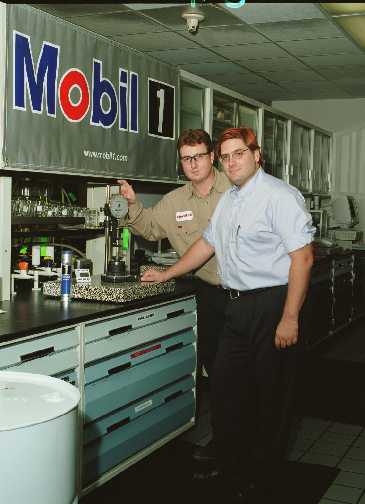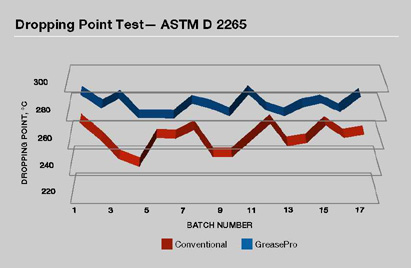ExxonMobil has become more exacting in its methods, changing the art of grease-making into a science, says the company, through several years of research and development and a $7 million capital investment.
The result is ExxonMobil’s new "GreasePro" technology, which allows the company to be more precise in the manufacture of its grease, improving performance characteristics for consistent lubrication of motor bearings and other components.
In addition, the company has recently received a patent relating to the manufacture of grease used in low-noise applications, such as HVAC equipment.

Controlling The Process
Grease-making is a complex process. (See sidebar below, “Getting Down To The Basics Of Grease.”) With conventional methods, grease is manufactured with repeated sampling, testing, and process adjustment. It’s the precise control of certain parameters such as heat, temperature versus time, and the shearing process which define the resulting batch of grease."Grease manufacturing is more complex than simply adding in the right amount of ingredients and letting it cook," said Chuck Coe, grease technical leader, ExxonMobil Lubricants & Specialties Company. "We have to control the level of heat at each stage of the process, control the way we dehydrate the mixture and how severely we shear the thickener molecules."
With its new GreasePro control technology, ExxonMobil uses a method that automatically controls critical process parameters. The secret lies in closely following a systematic protocol.
"We've invested in understanding the parameters from the crystallization stage to the shearing process to the finishing stage," stated Tim Nadasdi, senior research chemist, ExxonMobil Research & Engineering. "With conventional grease manufacturing methods, samples are taken from the resulting batch for quality assurance testing. With GreasePro, technicians do extensive measurements and testing at each stage of the process to ensure the batch is reacting as desired and make adjustments as needed. We have also designed protocols around the growth process of the thickener molecules to ensure an even distribution of the thickener throughout the batch of grease."
And the result? A tighter variability range.
"That translates into consistent temperature ranges and exacting measures on grease life," says Nadasdi.

The Proof Is In The Grease
In addition to careful control throughout the manufacturing process, ExxonMobil conducts tests on every batch of grease before products leave the plant.In the ASTM D 217 Cone Penetration test, which measures how firm or soft a grease is, the company says it has achieved consistent penetration results.
"In the past, batch-to-batch penetration results could vary significantly within an NLGI grade. (An NLGI grade allows a range of 30 tenths of a millimeter.) With GreasePro process control, we control variability to within a few tenths of a millimeter," said Coe.
He noted that the improved consistency in thickener content will decrease differences in the mobility and slumpability between batches of grease. By reducing the variation in mobility between grease batches, the amount of grease delivered to lubrication zones by central systems and manual methods will be more similar from batch to batch. That gives the end user the confidence that once the grease application is set-up, the equipment receives the optimum amount of grease every time it's lubricated.
In the ASTM D 2265 Dropping Point test, which measures the temperature at which the grease begins to soften and no longer functions as a thickened lubricant, the company also says it has achieved consistent results.
"That means we can be very exacting in our maximum usage temperature guidelines," Coe said. "If we tell customers that a particular grease can run at a particular temperature, they can be confident there will be minimal variability on high-temperature performance between batches."
Additionally, the company controls thickener content on every batch of grease, which correlates to the amount of oil which will bleed from the grease.
"We've recorded remarkably consistent oil-bleed properties," Coe related. "Since the correct amount of oil bleed from a grease is the most significant contributor to proper lubrication, the improved thickener-content consistency will help ensure that equipment is lubricated with a similar amount of oil every time a new batch of grease is used."

Assuring Low Noise
In addition to a plant expansion and development of GreasePro at its Beaumont, TX, facility, ExxonMobil's Olathe, KS, facility has also been at work on a plant upgrade and patenting the manufacturing techniques for its low-noise grease, Polyrex® EM."In recent years, there has been a growing demand for low-noise, or quiet, greases," Nadasdi said.
He explained that noise and vibration can be generated when bearing rolling elements are displaced as they collide with and roll over solid particles trapped in grease, such as external contaminants, as well as elements of the thickener. Low-noise grease is used in the bearings of noise-sensitive equipment, such as air conditioning units.
"Polyrex EM is a super-premium polyurea grease specially formulated for electric motor bearings," said Nadasdi. "It has outstanding long-life, high-temperature properties with excellent mechanical shear stability and corrosion resistance.
"Unlike conventional lithium-complex and polyurea greases, which might perform well in some high-temperature applications, Polyrex EM consistently performs well in extreme environments and offers low-noise benefits."
Sidebar: Getting Down To The Basics Of Grease
Grease is a semi-fluid, semi-solid material used to deliver oil to a lubricating contact, such as a bearing or any system with moving parts. Grease is used in virtually every industry and in applications ranging from fans to parts in the space shuttle.Grease consists of a thickener, and within the thickener a liquid lubricant dosed with performance additives.
"Think of grease like a sponge," said Chuck Coe, grease technical leader, ExxonMobil Lubricants & Specialties Company. "The sponge is the thickener, and the water in the sponge is the lubricant. The thickener keeps the grease in place, while the oil bleeds out in a controlled fashion to lubricate the moving parts."
And because of that thickener, grease-making is a complex process.
"Unlike the mixing of other lubricants, the manufacture of grease involves a chemical reaction. In the case of soap-based greases, that sponge or thickener is created through the mixing of a fatty acid and an alkali," said Coe. "Through the control of that chemical reaction, a three-dimensional crystal matrix is created with thousands of microscopic channels which hold the oil."
For additional information on ExxonMobil greases, visit the company’s website at www.exxonmobil.com.
Publication date: 01/13/2003

Report Abusive Comment